Do You Want to Pass Your Real Cisco DESGN 200-310 Dumps
Are you still searching for Cisco 200-310 dumps exam? The Designing for Cisco Internetwork Solutions (200-310 DESGN) exam tests network design for Cisco enterprise network architectures. CCDA certified professionals can design routed and switched network infrastructures and services involving LAN/WAN technologies for SMB or basic enterprise campus and branch networks. This 75-minute exam consists of 55-65 questions and covers Designing for Cisco Internetwork Solutions course. Candidates can prepare for this exam by taking it for the CCDA certifications.The pass4itsure 200-310 dumps DESGN certifies the switching knowledge and skills of successful candidates.
Designing for Cisco Internetwork Solutions
Exam Number: 200-310
Associated Certifications: CCDA
Duration: 75 minutes (55 – 65 questions)
Available Languages: English
Do you maintain 100% Guarantee on Pass4itsure.com products?
Yes. Our PDF of pass4itsure 200-310 dumps exam is designed to ensure everything which you need to pass your exam successfully. At Pass4itsure.com, we have a completely customer oriented policy. We invite the rich experience and expert knowledge of professionals from the IT certification industry to guarantee the PDF details precisely and logically. Our customers’ time is a precious concern for us. This requires us to provide you the products that can be utilized most efficiently.
Do you offer free after-sale services?
Yes. We provide 7/24 customer help and information on a wide range of issues. Our service is professional and confidential and your issues will be replied within 12 hous. Feel free to send us any questions and we always try our best to keeping our Customers Satisfied.
Pass4itsure Latest and Most Accurate Cisco 200-310 Dumps Exam Q&As(1-21)
QUESTION 1
DRAG DROP
Select and Place:
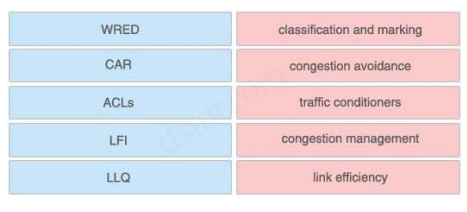
200-310 exam Correct Answer:

Explanation
Explanation/Reference:
Classification is the process of partitioning traffic into multiple priority levels or classes of service. Information in the frame or packet header is inspected, and the frame’s priority is determined. Marking is the process of changing the priority or class of service (CoS) setting within a frame or packet to indicate its classification. Classification is usually performed with access control lists (ACL), QoS class maps, or route maps, using various match criteria.
Congestion-avoidance techniques monitor network traffic loads so that congestion can be anticipated and avoided before it becomes problematic. Congestion-avoidance techniques allow packets from streams identified as being eligible for early discard (those with lower priority) to be dropped when the queue is getting full. Congestion avoidance techniques provide preferential treatment for high priority traffic under congestion situations while
maximizing network throughput and capacity utilization and minimizing packet loss and delay. Weighted random early detection (WRED) is the Cisco implementation of the random early detection (RED) mechanism. WRED extends RED by
using the IP Precedence bits in the IP packet header to determine which traffic should be dropped; the drop-selection process is weighted by the IP precedence. Traffic conditioner consists of policing and shaping. Policing either discards the packet or modifies some aspect of it, such as its IP Precedence or CoS bits, when the policing agent determines that the packet meets a given criterion. In comparison, traffic shaping attempts to adjust the transmission rate of packets that match a certain criterion. Shaper typically delays excess traffic by using a buffer or queuing mechanism to hold packets and shape the flow when the source’s data rate is higher than expected. For example, generic traffic shaping uses a weighted fair queue to delay packets to shape
the flow. Traffic conditioner is also referred to as Committed Access Rate (CAR). Congestion management includes two separate processes: queuing, which separates traffic into various queues or buffers, and scheduling, which decides from which queue traffic is to be sent next. There are two types of queues: the hardware queue (also called the transmit queue or TxQ) and
software queues. Software queues schedule packets into the hardware queue based on the QoS requirements and include the following types: weighted fair queuing (WFQ), priority queuing (PQ), custom queuing (CQ), class-based WFQ (CBWFQ), and low latency queuing (LLQ). LLQ is also known as Priority Queuing–Class-Based Weighted Fair Queuing (PQ-CBWFQ). LLQ provides a single priority but it’s preferred for VoIP networks because it can also configure guaranteed bandwidth for different classes of traffic queue. For example, all voice call traffic would be assigned to the priority queue, VoIP signaling and video would be assigned to a traffic class, FTP traffic would be assigned to a low-priority traffic class, and all other traffic would be assigned to a regular class.
Link efficiency techniques, including link fragmentation and interleaving (LFI) and compression. LFI prevents small voice packets from being queued behind large data packets, which could lead to unacceptable delays on low-speed links. With LFI, the voice gateway fragments large packets into smaller equal-sized frames and interleaves them with small voice packets so that a voice packet does not have to wait until the entire large data packet is sent. LFI reduces and ensures a more predictable voice delay.
QUESTION 2
DRAG DROP
Select and Place:
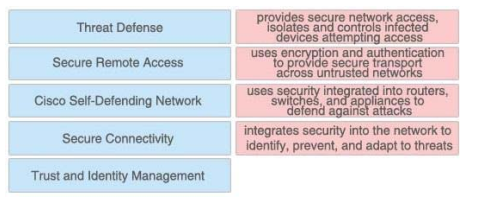
Correct Answer:

Explanation
Explanation/Reference:
Trust and identity management solutions provide secure network access and admission at any point in the network and isolate and control infected or unpatched devices that attempt to access the network. If you are trusted, you are granted access. We can understand “trust” is the security policy applied on two or more network entities and allows them to communicate or not in a specific circumstance. “Identity” is the “who” of a trust relationship.
The main purpose of Secure Connectivity is to protect the integrity and privacy of the information and it is mostly done by encryption and authentication. The purpose of encryption is to guarantee confidentiality; only authorized entities can encrypt and decrypt data. Authentication is used to establish the subject’s identity. For example, the users are required to provide username and password to access a resource…
QUESTION 3
DRAG DROP
Select and Place:
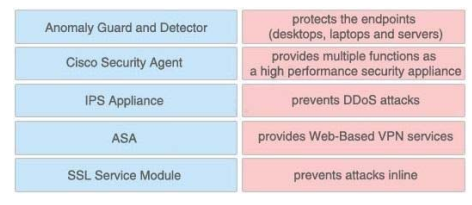
200-310 dumps Correct Answer:

Explanation
Explanation/Reference:
QUESTION 4
DRAG and DROP
Select and Place:
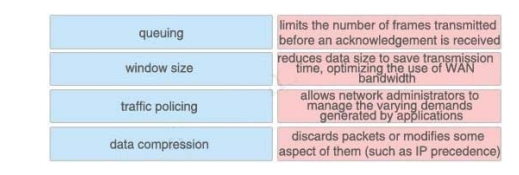
Correct Answer:

Explanation
Explanation/Reference:
QUESTION 5
Drag the WAN characteristics on the left to the branch office model where it would most likely to be used on the right.
Select and Place:
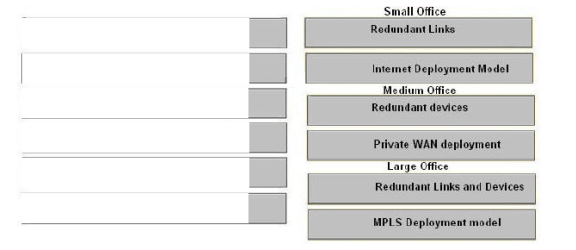
200-310 pdf Correct Answer:

Explanation
Explanation/Reference:
QUESTION 6
The first phase of PPDIOO entails identifying customer requirements. Drag the example on the left to the associated requirement on the right
Select and Place:

Correct Answer:

Explanation
Explanation/Reference:
QUESTION 7
Drag the description or characteristic on the left to the appropriate technology or protocol on the right.
Select and Place:


Explanation
Explanation/Reference:
QUESTION 8
Click and drag the phases of the PPDIOO network lifecycle approach on the left to their order on the right.
Select and Place:

Correct Answer:

Explanation
Explanation/Reference:
QUESTION 9
Drag the characteristics of the traditional campus network on the left to the most appropriate hierarchical network layer on the right.
Select and Place:
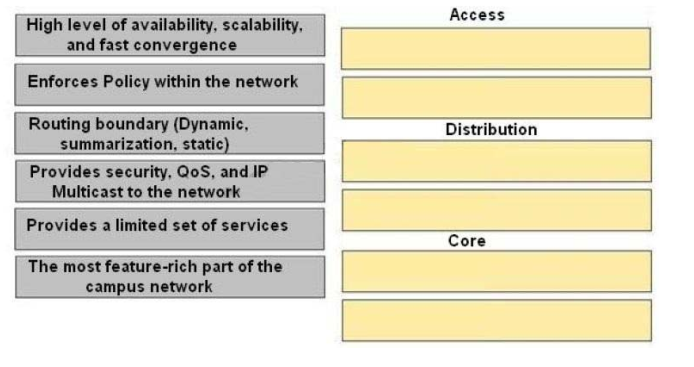
200-310 exam Correct Answer:

Explanation
Explanation/Reference:
QUESTION 10
Drag the network function on the left to the functional area or module where it is most likely to be performed in the enterprise campus infrastructure on the right.
Select and Place:
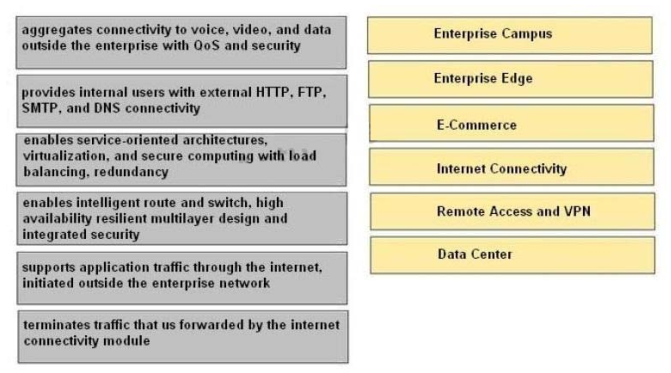
Correct Answer:

Explanation
Explanation/Reference:
QUESTION 11
Drag the security prevision on the left to the appropriate Network module on the right.
Select and Place:
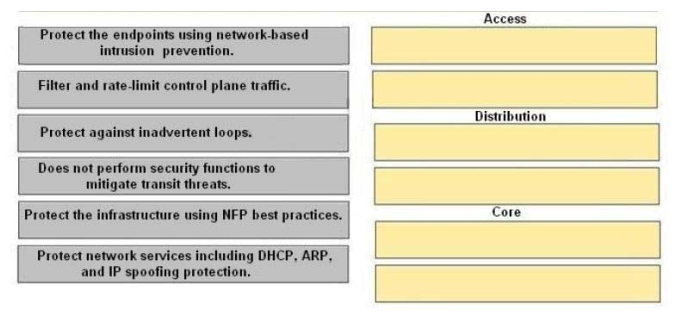
200-310 dumps Correct Answer:

Explanation
Explanation/Reference:
QUESTION 12
Drag the technology on the left to the type of enterprise virtualization where it is most likely to be found on the right.
Select and Place:
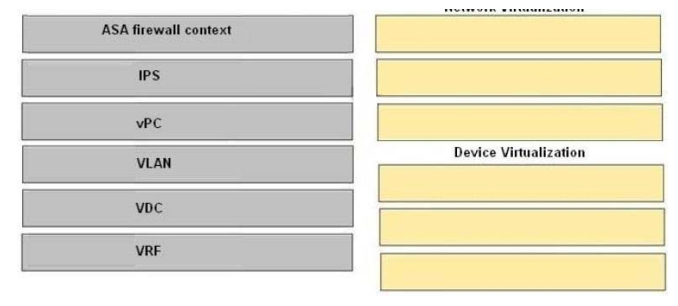
Correct Answer:
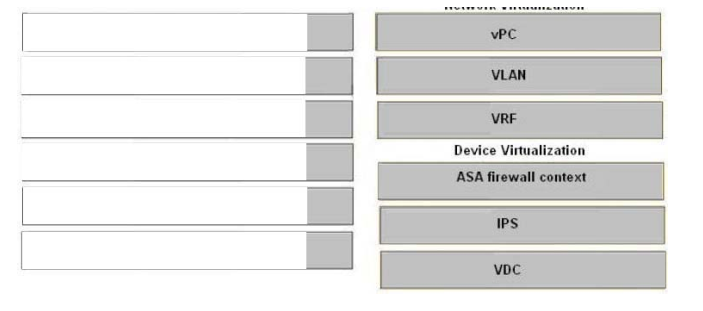
Explanation
Explanation/Reference:
QUESTION 13
Drag the network characteristic on the left to the design method on the right which will best ensure redundancy at the building distribution layer.
Select and Place:
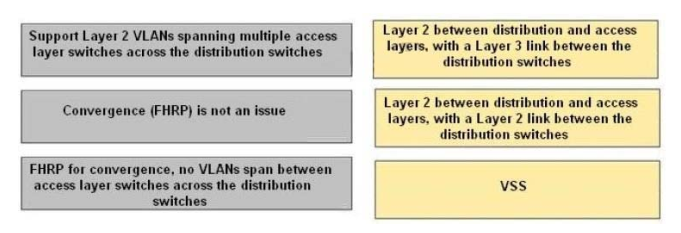
200-310 pdf Correct Answer:
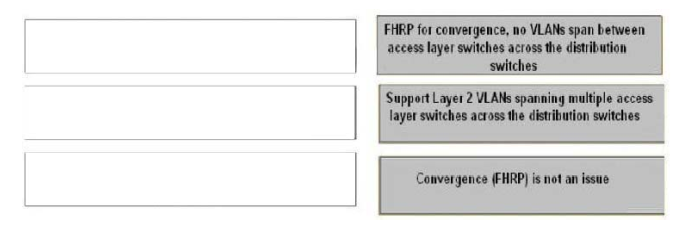
Explanation
Explanation/Reference:
QUESTION 14
Drag the associated virtualization tool or solution on the left to the appropriate design requirement on the right.
Select and Place:
Correct Answer:

Explanation
Explanation/Reference:
QUESTION 15
Drag the WAN technology on the left to the most appropriate category on the right.
Select and Place:
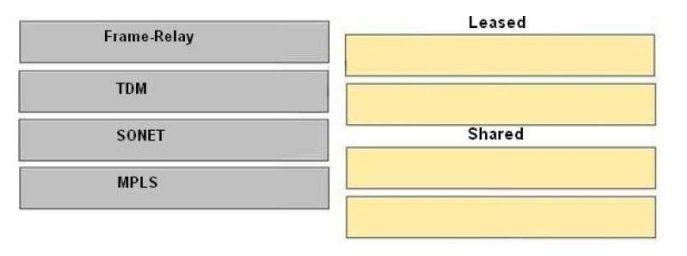
200-310 exam Correct Answer:
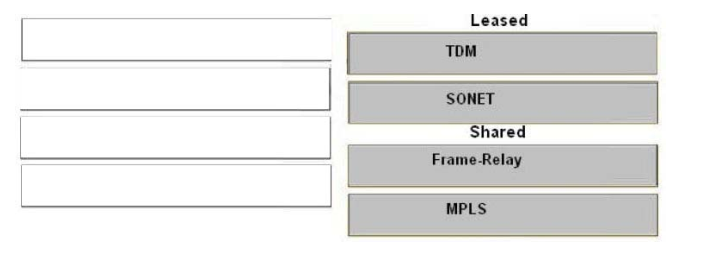
Explanation
Explanation/Reference:
QUESTION 16
Drag the STP toolkit term on the left to the definition on the right.
Select and Place:
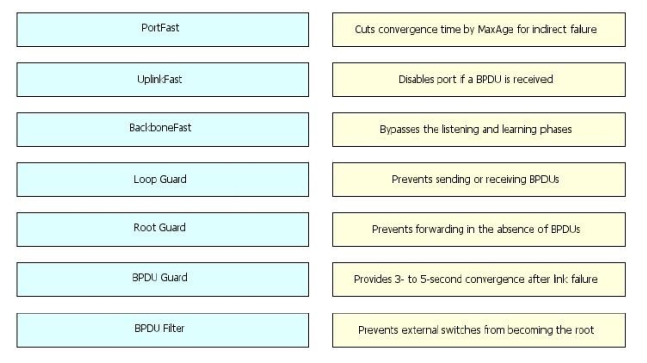
Correct Answer:
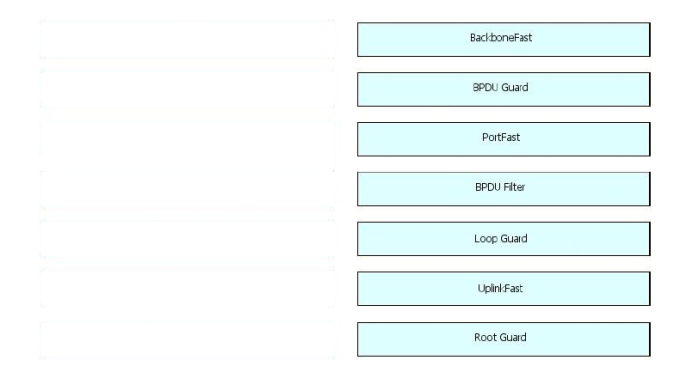
QUESTION 17
Drag the characteristic on the left to the correct campus design model on the right.
Select and Place:
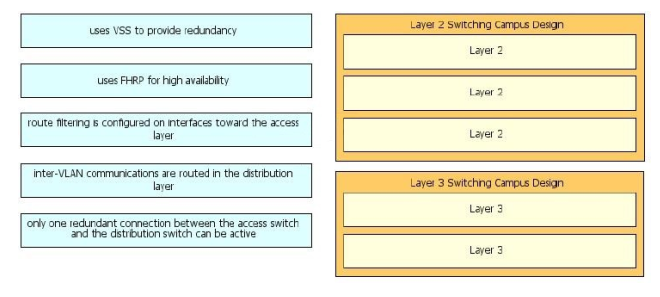
200-310 dumps Correct Answer:
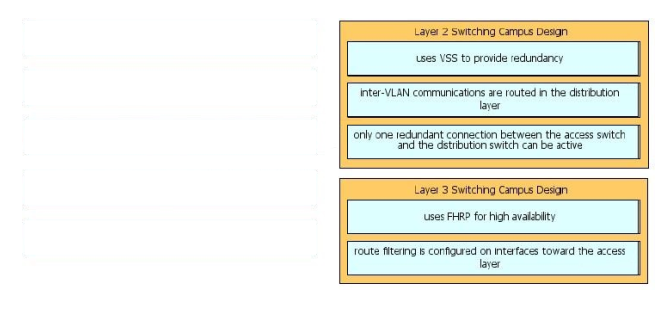
Explanation
Explanation/Reference:
QUESTION 18
Drag the technology on the left to the matching routing protocol on the right.
Select and Place:
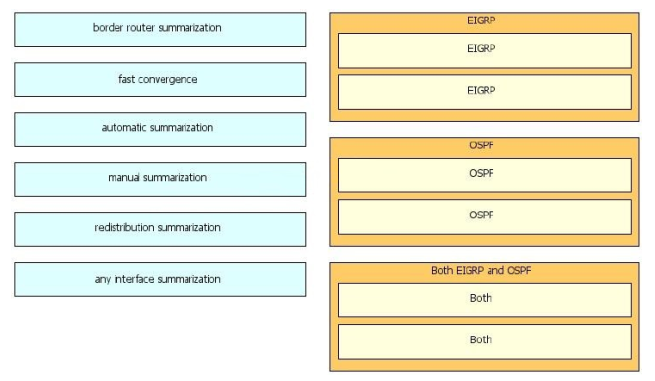
Correct Answer:
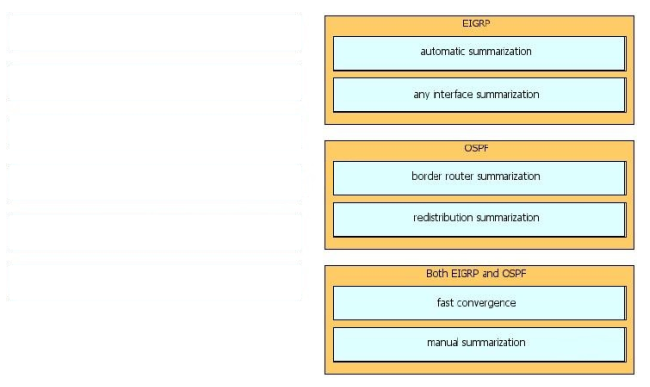
Explanation
Explanation/Reference:
QUESTION 19
Drag the security term on the left to the matching description on the right.
Select and Place:
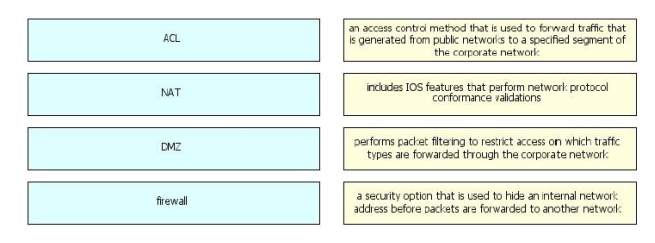
200-310 pdf Correct Answer:
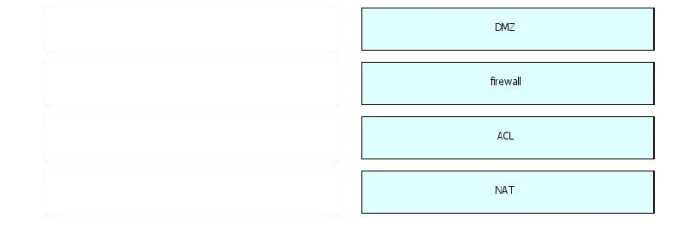
Explanation
Explanation/Reference:
QUESTION 20
Drag the term on the left to the matching deployment scenario on the right.
Select and Place:

Correct Answer:
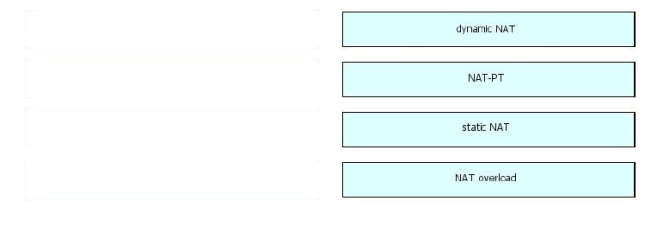
Explanation
Explanation/Reference:
QUESTION 21
Drag and drop the top-down approach process step 1 – 4 !
Select and Place:
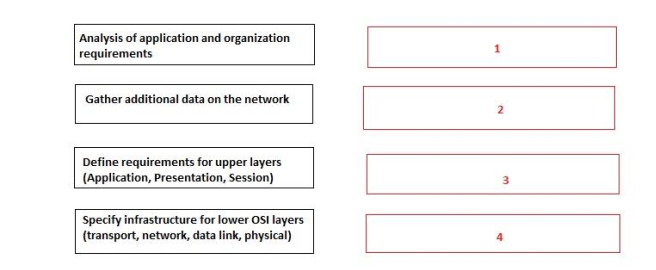
200-310 exam Correct Answer:
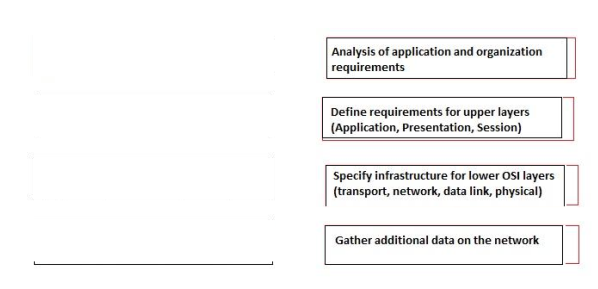
Cisco 200-310 Dumps Recommended Training
The following course is the recommended training for this exam.
- Designing for Cisco Internetwork Solutions (DESGN) v3.0
Courses listed are offered by Cisco Learning Partners-the only authorized source for Cisco IT training delivered exclusively by Certified Cisco Instructors. Check the List of Learning Partners for a Cisco Learning Partner nearest you
[New Pass4itsure Cisco 200-310 Dumps PDF From Google Drive]: https://drive.google.com/open?id=0BwxjZr-ZDwwWajNRNzNfaDllX3M
[New Pass4itsure Cisco 200-355 Dumps PDF From Google Drive]: https://drive.google.com/open?id=0BwxjZr-ZDwwWUkUwT0lYclNxbFU
The 200-310 (DESGN) Designing for Cisco Internetwork Solutions exam is a 75-minute, 55-65 question assessment that is associated with the CCDA certification. This pass4itsure 200-310 dumps exam tests a candidate’s knowledge of network design for Cisco enterprise network architectures. CCDA certified professionals can design routed and switched network infrastructures and services involving LAN/WAN technologies for SMB or basic enterprise campus and branch networks. A candidate is tested on knowledge of Designing for Cisco Internetwork Solutions course maintenance.

In the recent few years, pass4itsure Cisco 200-310 dumps exam certification have caused great impact to many people. Because pass4itsure exam dumps contain all questions you can encounter in the actual exam, all you need to do is to memorize these questions and answers which can help you 100% pass the exam. This is the royal road to pass 200-310 dumps exam.
Cisco 200-310 dumps pdf training tool has strong pertinence, which can help you save a lot of valuable time and energy to pass IT certification exam. Our exercises and answers and are very close true examination questions. IN a short time of using Pass4itsure 200-310 dumps pdf simulation test, you can 100% pass the exam.
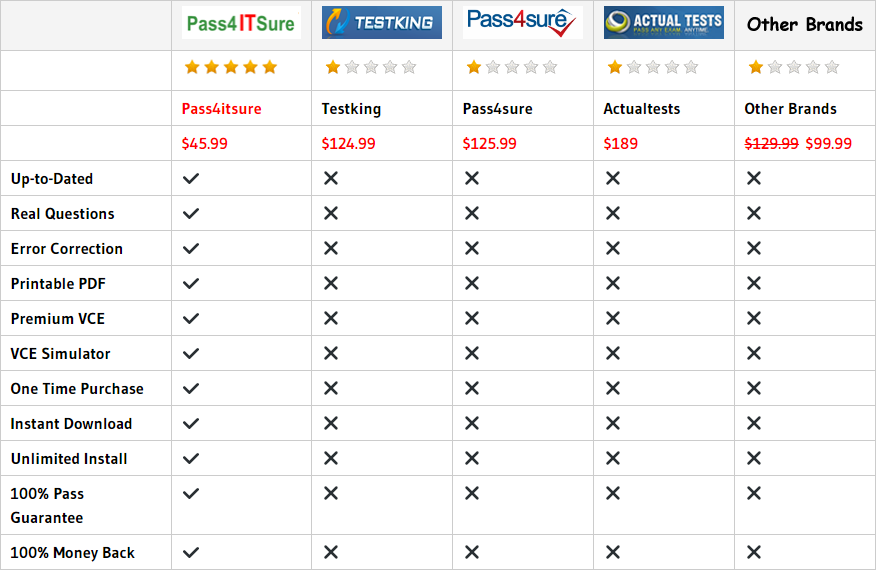
Download Pass4itsure Cisco 200-310 Dumps, Real Cisco 200-310 Dumps Real Questions Answers With New Discount, We Help You Pass Designing for Cisco Internetwork Solutions.
